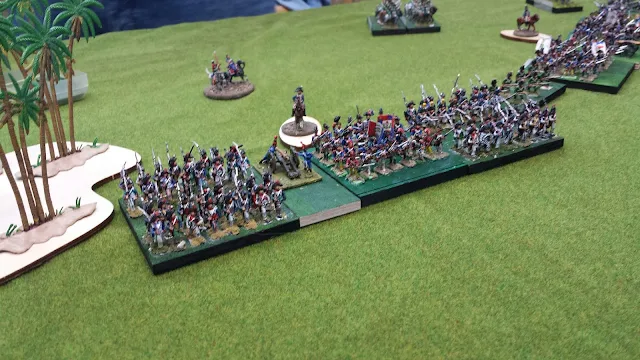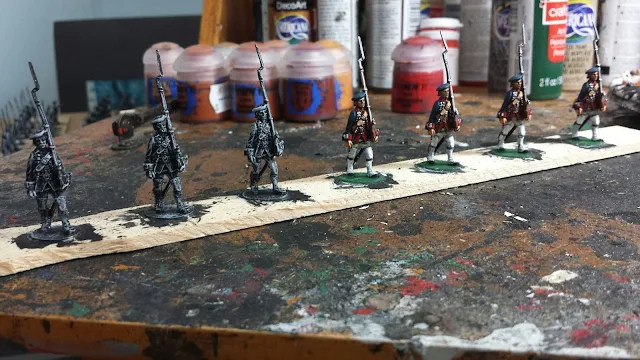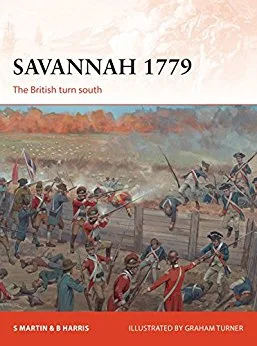Thursday, September 14, 2017
Battle of the Pyramids
My good friend George invited me up the other day for a game. He had been cleaning out his shed and setting up his gaming area in it and wanted to break it in. I had the day off so I joined George, Ralph, Earl and Mike . This was great fun for me as I had not been able to game with them for too many years due to work and life.
George had been working on his French Revolution 15mm army for some time. He, like many in the club are great fans of the Volley and Bayonet rules set which he is running for this time period. Mike brought his Turkish/Arab army which stood in for the Egyptian army. After painting and playing with 25mm figures it was an interesting experience playing with 15mm.
For those not familiar with the rules these are big battle and big scale battle game. A stand or base is a brigade. Or in the French army case a demi brigade. The rules have a lot of board game aspects to them and reward a good plan.
The game started with the French advancing into the table. They had planned to camp in the oasis area. Once they were set up the Egyptian army could set up. While the French had a good mixed force of troops the Egyptian army was heavy on cavalry with very poor quality infantry and two gigantic cannon which once placed could not move. Mike and I had the Egyptians, Ralph and earl the french.
We set up our Egyptian force with all the cavalry in our right, artillery in the center and our infantry on the left. We hoped to try and attack and roll up the French while our infantry kept them busy.
Our cavalry attacked in two waves and did pretty well. We forced back two demi brigades and pushed back his small cavalry force. Earl quickly put the remaining French infantry together and went stationary. This gave him extra dice to throw and made his infantry extra hard for the cavalry to fight. Massed as they were with their artillery there was very little chance of the cavalry breaking them. This ended our attempt to roll them up.
On our left flank both infantry lines eyed each other cautiously but aside from some long range minister shooting little fighting broke out. In the center the French managed to stay out of range of our artillery the entire game. Clever fellows those French! The highlight of the game was when Ralph threw double six's when rolling for musket fire. A moment that will live in immortality in our club lore. Ok, you had to be there.
All in all a very colorful and enjoyable game. These are not a time period i usually game nor are the rules my usually cup of tea. But they moved along quickly, provided a fun game and a very enjoyable day. Many thanks to all for a wonderful time.
Sunday, September 10, 2017
More Crann Tara French work in progress
Couple more "work in progress" pictures. i have taken a slight break from French white uniforms to paint more blue coats. Here are the first of my Royal Ecossais regiment from Crann Tara miniatures. I really like the figures. A neat looking regiment; colorful and fun to paint.
Here is how I paint my figures. I mount 8 figures on painting stick. These are paint stirrers I get there from Home Depot. They used to be free but now they are charging for them so shame on them!
I prime my figures with black with gesso; then when dry I dry brush the figure white. This gives me darker colors in the folds but lighter colors in the raised surface.
Examples of primed figures and painted figures.
More to come soon. Have finaly gotten the knack of French white uniforms and will be finishing two battalions soon. And a big shout out of thanks to Aly' s Toy Soldiers blog. His examples of how to paint white is brilliant and works very well.
Monday, September 4, 2017
Work in progress: French Infantry 1745
Projects are funny. Sometimes you start a new project because it's a period you love. Other times it's a long time you just wanted to do it. There are lots of reasons why. Some good, some well justified. A few it's just because. And so in a moment of not right mindedness i have decided to paint French, and later British for the mid eighteenth century.
A new project you say? Well, projects (in our wargaming world) are funny things. At times they blossom into wonderful table top armies. Other times they sputter out as massive piles of lead. Some are favorite time periods, or long held desire to just create it. Too many are flights of fancy that do not last the month and leave unpainted mounds of lead. My Crimean armies are almost done; someday I will add Turks but not now. My War of 1812 has taken up all my time for a year but now I need a break before returning. My Rev War armies are still growing but again i need a time away from the painting table and something different.
So here I am looking down the tunnel of a small project. I have always enjoyed the writing of Charles Grant, both father and son. Many hours have I spent in their company via their books and articles. This past vacation a I had a most excellent time reading their imagination campaign series. The Table top teasers series are always a source of inspiration. And, I would enjoy refighting them on my table. I could do so with any of my other armies. But that would not seem right. Instead I would like to do so in the eighteenth century. A pair of traditional foes seems right. Nothing against Prussia and Austria but I lean towards the the French And British Armies. My plan is for a handful of regiments, from the Crann Tara and Minden Miniatures range of figures. More War of Austrian Succession then seven years war.
Painting is interesting as having started with French they are so different from what I have been painting that I have to seek advice on how to paint white uniforms. They are a mystery to me. Fortunately many out there have come to my assistance. I post a half done picture of my first attempt with the French having used off white grey then highlighted with white. Still experimenting. So stay tuned for more.
Sunday, September 3, 2017
Savannah 1779
By 1778 the war in the North had turned for the British. Burgoyne had surrendered which brought the possibility of French intervention. Following the battle at Monmouth both sides had fallen into a war of posts and skirmishing. Refugees from the southern colonies recommended moving south where a land of loyalists awaited the British with open arms.
And so, Sir Henry Clinton decided on a small gamble with limited forces. Colonel Archibald Campbell was Sent south with a small force of 3,000 men consisting of the 71st Highlanders, four loyalist battalions and two Hessian battalions. He over ran Georgia and in his words removed one star and one stripe from the new American flag. American reinforcements joined together and a see saw campaign resulted back and forth across the South Carolina Georgia border. The landing of A French army with naval support push the British into Savannah in a scenario similar to Yorktown but with different results. Savannah 1779 details that campaign.
A often forgotten campaign in the Rev War it is nevertheless a fascinating campaign and perfect for the war game table. Armies and battles are small and colorful. There are linked battles which could form a neat campaign. Uniforms are colorful. Personalities are fascinating. And you can field a French army which actually fought! Battles range from full sieges to small skirmishes to battles between. In addition it is a good read which is in itself a good reason to pick up this book. Highly recommended!
Thursday, August 17, 2017
SUPERMARINE SPITFIRE MK.IX
After watching the Spitfire that landed here at Worcester airport the other day I wanted to learn more about it. What I found out was truly amazing.
Supermarine Spitfire MK.IX tail number BR601 first flew in June 16, 1942. It was the sixth conversion from a model M.V into a MK.IX. During its history it flew 116 combat missions and was piloted by two aces. These were Australian ace Tony Gaze who had 12.5 victories and also Colin Grey from New Zealand who had 27.5 victories.
So what I saw landing the other day was a true piece of history in front of me.
For more on BR601 and it's long distinguished history please see the Collin's foundation website. Here is a link with much more details:
http://www.collingsfoundation.org/aircrafts/supermarine-spitfire-mk-ix/
And if you are in the area please come to the Worcester airport on September 22 - 24, 2017 to see many of these restored aircraft fly once again.
Monday, August 14, 2017
Always something interesting at Worcester airport!
At work the other day, while waiting for flight 2020 to land a customer ask what kind of aircraft that was that just landed. Distracted by printing off the flight dispatch and other items for the arriving flight I mentioned that there are a number of small private planes which use the airfield. Turning to look out the window I was shocked to see a Spitfire! It had just landed and was taxiing past us and up to the hanger.
The spitfire is owned by the Collins Foundation. It is part of a fleet of aircraft and other vehicles from WW2. Turns out they rotated smaller aircraft around the country for air shows. There are a few others coming in soon. If you are interested there will be a show here at the Worcester Massachusetts airport the weekend of September 22 to 24. More information to follow.
Sunday, August 6, 2017
Mr Madison's War rules for War of 1812
These rules for gaming the War of 1812 originally started out as a set of rules for The American Revolution by Jim Purkey at Fife and Drum miniatures. These are offered free on his miniature site. I liked them, and made a few changes to better reflect the new time period. In addition i have posted a few clarifications and additions here to how we play the game.
Move first, fire second, move second, fire first: when it is your turn to fire remove all casualties from hits. No, casualties removed do not get to return fire that was the advantage of firing first.
Retire facing or not facing enemy: deduct 2" from move to retire with back towards enemy. Half move to retire facing enemy or move sideways.
Charges or moving into melee: during your move declare charge. Defender tests morale, if pass they stand and can fire at charger if not retire column distance back shaken. There is no charge move bonus. Fight two rounds of melee then loser (most casualties) tests morale. If pass then winner tests. If both sides pass then attacked is considered to have failed to push back defender from their position. The attacker retired one column move back towards their line facing the enemy.
Routing units effect on other units: ignore friendly units routing past if router is lower morale. Take morale test if equal or better morale.
Multiple units in melee: If two units vs one distribute casualties evenly to both units.
Wheeling regiments: Wheels are made from the left, right, or center of the unit only.
Fences, small streams: Units move up to them and stop move. Next move you cross obstacles and continue your move. If both units are touching the same fence line and facing each other across it neither gets the benefit of the fence.
Artillery: one operation costs 1/2 move, this included fire. So you can limber and move half movement; move full move if limbered; unlimber and fire Artillery cannot enter woods, need infantry to knock hole in fences to cross. Any friendly unit within a friendly artillery arc of fire, if the arc of fire goes through two opposite sides of that friendly unit the artillery can not fire. Arch of fire is measured from cannon barrell, with of stand forward like a bowling alley
Difficult terrain (fields, Rocky ground): cost 2" for every 1" of movement in it
Woods; units stop movement at edge of woods. They enter next turn (similar to fences). Once in woods skirmishers troops (skirmishes or Indians) move their full movement, while formed troops move half their movement. Small arm range is half. Only skirmishes get cover modifiers. Yes, it sucks for regulars in the woods (please ask General Braddock).
Indians: always unformed, in mass formation (I.e. in a bunch). No penalty to change direction. In woods move full movement. Units fired at by Indians for first time check morale. In open clear terrain go one step down chart for firing and morale (if on line "C" use line "D"). Indians are not shock troops. They race about being obnoxious and scaring volunteers and militia who are not used to them.
Rockets: roll d10.
10 = hit, one casualty and test morale.
6 - 9 = test morale
3 - 5 = miss
2 = hit nearest friendly unit test morale
1 = rocket doubles back, destroyed battery
Here is a link to Jim's blog where he explains how to play his rules. Very well done explanation with clear examples of play.
http://altefritz.blogspot.com/2017/08/fife-drum-awi-rules-tutorial.html
Subscribe to:
Posts (Atom)


















